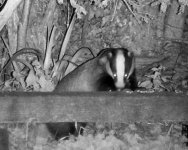Mark, Jan and others,
How would you rate quality of the image and pleasure of watching an animal? Is it 'OK, species can be IDed, not so bad' or more like 'in BBC wildlife films'?
How would you rate durability of your equipment? Would you take them freely in the rain and to the tropics? On my trips always some guy seem to lose his camera or telephoto lenses due to tear and wear. Are they more or less sensitive to abuse, rain, humidity, dust, vibrations, etc.?
I still did not choose a type. IR binoculars have advantage that they feel the same as familiar binoculars. But they only extent the existing light, so animals may be less visible. On the other hand, colors can possibly be seen. They are also relatively cheap.
There are IR googles, which are said to be better than bins for soldiers, but I never heard about anybody using them for wildlife. Why?
There are also thermal monoculars. Apparently wildlife glows from heat, which makes them more visible, and the flming can be integrated. On the other hand, natural colors are apparently invisible and they are extremely expensive. I am also worried about the stability of electronics, and how resistant it can be outdoors and in the tropics.
Opinions about different types, and brands within types?
I wonder if there is some consensus being formed about wildlife watching?
Any experience from field biologists or safari rangers in Africa?







